101 Golden Retriever Fun Facts (+ The Cutest Puppy Photos!)
There are few dogs in history more famous and easily recognized than the golden retriever. They’re our smiley, lovable, long-haired best friend from all the movies, TV shows, and more!
They say that 101 facts about Golden Retrievers are just the tip of the iceberg when mentioning this dog’s amazing characteristics. But it turns out they aren’t just cute and cuddly companions: They’re a breed with a rich, ancient history and full of fun facts.
Let’s take a fun, in-depth look at one of America’s most popular dog breeds!
Golden Retriever History Facts
The Golden Retriever breed has been around since the early 1830s.
In fact, Golden Retriever facts will reveal to you that this beautiful dog even has aristocratic roots. It was Dudley Coutts Marjoribanks who developed the Golden Retriever in Scotland during the mid-to-late-1800s.
A flat-coated retriever and Tweed water spaniel were bred to bring about the Golden Retriever. The Golden Retriever was recognized by the American Kennel Club in 1925 as a registered breed.
They earned their namesake because they were originally bred for bringing back waterfowl shot by hunters out of the water.
Sport hunting in Europe and North America increased interest in the development of gun dogs and Setter, Pointers and Retrievers have specific attributes that make them superb sporting- and gun dogs. It’s why they love water so much. It comes from decades ago when there was the need for a gun dog that could plunge fearlessly into the water to retrieve game from the water after being shot down.
The breed was originally created by Lord Tweedmouth of Scotland to be his attractive, cheerful hunting companions. After all, Dudley Marjoribanks, 1st Baron Tweedmouth, couldn’t possibly collect all of those birds himself!
It would have been impossible for him to navigate the marshes, bogs, water, and land to retrieve the birds were it not for his energetic, enthusiastic Golden Retriever companion. These working dogs retrieved ducks and waterfowl during hunting trips and would gently pick the birds up without breaking their bones.
Tweedmouth got that distinctive long-haired golden look from mixing the Tweedwater Spaniel, a now-extinct breed, with the Flat-Coated Retriever.
The Tweed Water Spaniel became extinct but is best known for being involved in the y development of the Golden Retriever breed of dogs. The Flat-Coated Retriever breed is a strong, muscular dog with an intelligent, friendly expression. They come in 3 colors and they have a strong desire to please people.
They used to call the breed the “golden flat coat” because of their distinctive coat, a feature they took from the Flat-Coated Retriever.
You may well think that the Flat-Coated Retriever is much the same as the Golden Retriever, but it’s not. The Flat-Coated Retriever is a distinctive breed, a natural breed with strong hunting abilities.
Later in their history, to further diversify the breed from the pack, Newfoundlands, Bloodhounds, Labrador Retrievers, and Red Setters were introduced.
It was during the late 1800s that Lord Tweedmouth created the Golden Hair Retriever by mixing several breeds together – the Irish Setter, the Bloodhound, the yellow Flat-Coated Retriever, and the Water Tweed Spaniel. This resulted in the Golden Flat-Coat dog. Later on, the dog was named the Golden Retriever.
The breed’s coat is designed to be relatively waterproof, making them great swimmers.
The Golden Retriever has a double coat with a short undercoat below the coat. Both the layers help to insulate the dog against cold, moist weather. The double coat also has a waterproofing effect.
Those coats come in two distinct layers, the upper, wiry one keeping water from penetrating the fluffy lower coat.
The Golden Retriever has a double coat, meaning there is a topcoat and a bottom coat. The outer coat of the Golden is slightly more coarse than the soft, fuzzy undercoat. Both the layers have an important role to play – protecting the skin from moisture, cold, and heat.
Some urban legends say the breed originally came from a pack of Russian sheepdogs in a traveling circus. (That’s just an old wives tale, though).
But it nonetheless makes you think of these pet urban legends. After all, Golden Retrievers love learning new tricks and they are easy dogs to train. People say their antics, their smiling face and the way they train so easily is because they once performed in a Russian circus. There is no truth in this pet urban legend.
The breed was made official in 1925 when they were registered with the American Kennel Club.
To this day Golden Retrievers are one of the most popular show breeds. This beautiful dog was first shown at the Crystal Palace Dog Show in England in 1908. The American Kennel Club recognized the dog in 1925. The American Kennel Club is the world’s biggest purebred dog registry. To become a recognized breed, a dog must have an interested, active following of admirers and this the Golden Retriever has in abundance.
Interesting Golden Retriever Number Facts
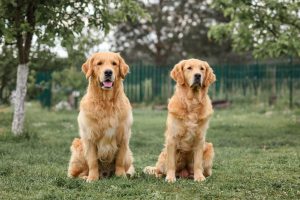
Typically, a healthy Golden will weigh between 55 to 75 pounds. They are large dogs with the males being about 23 to 24 inches tall.
The males weigh in at about 65 to 75 pounds. The females can be anything from 21 to 24 inches in height and they can weigh between 55 to 65 pounds.
They usually stand somewhere between 1 foot 9 inches tall and two feet, making them great medium-sized dogs.
Because nothing is set in stone and a Golden Retriever is totally unique, you can safely class your Golden as a medium to large breed. Some will be a little larger and some smaller, but they are always beautiful strong athletic dogs.
Goldens usually have a 10 to 12-year life span, making them great family dogs.
So while the Golden typically lives between 10 and 12 years of age, with good nutrition, good exercise, and a wonderful lifestyle for your pet, he can push through to 17 years of age and even older.
The females are typically smaller than the males, only measuring up to about 21.5 to 22.5 inches and weighing in around 55-65 pounds.
While this is true, that’s the cool thing about purebreds like this. You can always pretty much rely on the standard, but there are always variations. Don’t be surprised if you buy a pair of Golden Retrievers and you find your female to be larger than the male.
There are three different types of Golden Retrievers, the American, British, and Canadian versions. Each one is different in a few subtle ways.
The differences are so slight that you can’t be blamed for getting them a little mixed up. One thing is certain, they are all purebreds and they all fall under the one Golden Retriever breed.
- The Canadian Golden Retriever looks just a bit different from the other two in that his coat is darker and shorter and not quite as thick as the other two. The shorter hair also means less feathering on the neck, tail, and legs.
- The British or English golden retriever is more solidly built than the Canadian and American retrievers. English goldens also tend to be just a bit smaller than the other two varieties.
American Goldens tend to have thin, dark coats and are usually the thinnest of the three.
The American Golden Retriever is the most popular of the three. Its coat is darker in color than the other two varieties and it is generally taller and slightly more slender.
Canadian Goldens usually have darker coats and can sometimes be the tallest of the three options.
The darker coats can lean towards being a dark reddish color, almost like a Red Setter.
British Goldens tend to be the lightest in color and are usually stocky and muscular.
English Golden Retrievers are characterized by their muscular, stocky builds. The entire head and neck area are bigger. Their coats can be very light or golden.
All three types of Goldens share the same head shape, with a broad, straight muzzle that comes to a well-defined stop.
In fact, while the three types of Golden Retriever differ slightly, all three are famous for their beautiful coats, the broad head, the well-spaced eyes, and straight, bluntish muzzle. These features are the breed’s hallmark.
Interestingly, your dog’s head shape could predict how long it’s going to live. Generally, dogs with sharper pointed faces and wolf-like features tend to live way longer than their flat-faced cousins.
Predicting the lifespan of your dog isn’t something that is a hard and fast rule. However, apart from doing things that can promote longevity such as good nutrition, the shape of your dog’s head and muzzle can also give you a hint as to his longevity. Dogs with longer, more pointed faces live longer than broader-faced dogs such as the Golden Retriever.
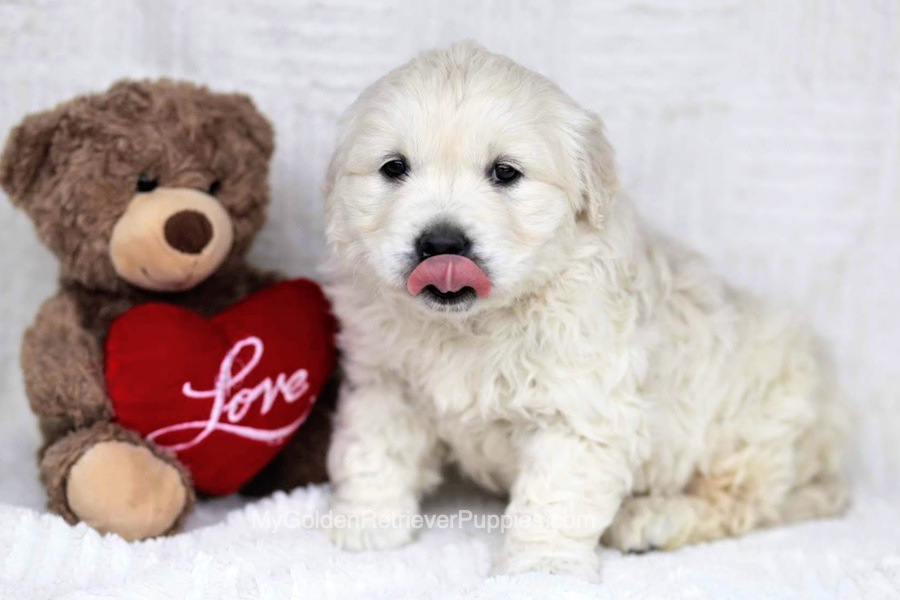
Facts About a Golden Retriever’s Appearance
Their special waterproof coat serves as a natural protection and helps the Golden protect itself from both the heat and the cold.
The coat of the Golden is dense and water repellent complete with an undercoat. The coat protects the dog from the heat and the cold and therefore the Golden’s coat should never be trimmed. Occasionally, excessive length can be trimmed a bit but everything the Golden represents shouldn’t be altered by trimming or cutting. The coat creates a waterproof jacket for the dog.
They should never be shaved or have their coats cut very short unless needed for a medical reason. (That coat is long and fluffy for good reason!)
The long coat protects the Golden from the heat and the cold and it should never ever be cut except for medical reasons as suggested. Its beautiful coat serves a purpose.
The fur along the underside of the dog’s stomach, on the back of its legs, and from its neck onto its chest tends to be longer and wavier than most of their other fur.
You can always pick out a Golden Retriever with his long golden locks. It is at about 3 months of age that long feathery hair starts appearing on your puppy’s tail and at about age one you see this feathery hair on the legs and under their stomachs.
Despite their name, Goldens actually range in shades. Some are a much darker, richer gold color, almost orange even, while others are much duller and muter yellow cream color.
Golden Retriever colors are quite varied in the golden color range. You can see shades that are milky, some creamy, some gold, and some red. Not all the colors are recognized as a standard color by the American Kennel Club. The official colors are golden, lightly golden, and dark golden.
Some breeders are even selling white Goldens, even though they’re not officially recognized by the American Kennel Club.
It doesn’t matter what these so-called rare white golden retrievers are called, they are golden retrievers. Even though they are immensely popular, a white Golden is frowned upon by the British and American kennel clubs.
You can usually get a pretty good indication of what shade your puppy is going to end up being by checking their ears.
Most Golden Retriever owners will tell you that if you want to get some idea about your dog’s future coat color, you can look at your puppy’s ears color. Golden Retrievers do change color as they grow but the adult coat is never much different from the color of the puppy’s ears.
Goldens tend to have their coats get darker as they age, usually getting their true color by about a year old.
Golden Retrievers promise to stay beautiful forever but their fur does get darker as they grow older.
At about a year old, a Golden is considered full-grown.
A Golden Retriever may well have reached his full size by one year of age, but mentally they only reach maturity at about 18 months of age.
The same goes for your dog’s nose, which will start out naturally brown or black.
Your Golden’s nose can change color for various reasons, and a black nose that turns pink can be because of aging, seasonal changes or it can be because of some medical problem.
As they get older, however, don’t be surprised if some of that pigment fades a bit.
As a golden ages, there will be pigmentation changes and your dog’s nose may even become pinker.
Goldens are one of the few dog breeds that can get a condition called “snow nose,” causing pink spots to pop up during the colder months of the year. What Is a Snow Nose Golden Retriever?
The term ‘snow nose’ means your dog’s nose will fade to a more pink or white shade during the winter months. It comes about because of a breakdown of an enzyme known as tyrosinase, which produces pigment. This Tyrosinase is seen in order dog breeds too, one of which is the Husky.
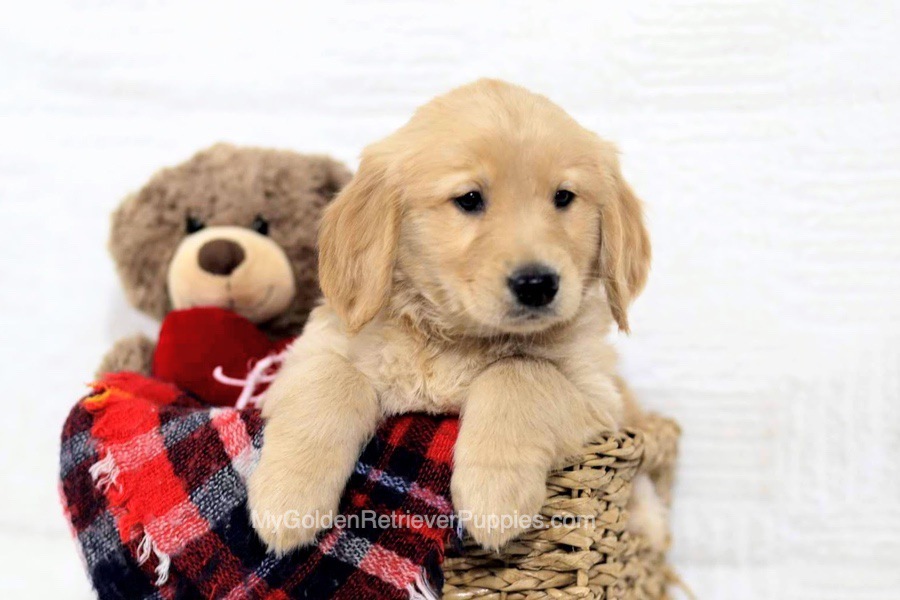
Things to Know About a Golden Retriever’s Behavior
Golden Retrievers are considered to be “sporting dogs” because of their storied history as hunting companions.
As sporting dogs, these Goldens are going to need plenty of exercise. As active members of the sporting group, they are always ready for action and are natural athletes. They are used for everything from hunting and tracking to rescue.
Goldens are known for their kind, friendly, and confident demeanor, a selling point for their breed.
It’s what makes the Golden so popular – this happy, caring nature of the Golden Retriever who wants to be your best friend.
Because of their extreme friendliness, Goldens aren’t the best choice if you’re looking for a serious guard dog. They’re more likely to roll over and drop their ball at an intruder’s feet than they are to attack.
Don’t underestimate your Golden. True, they’re too friendly to make good watchdogs, but to protect you from an intruder, they can show you a courageous, protective nature.
If you’re looking for a bright pup, a Golden is the way to go.
They’re actually ranked the world’s 4th smartest breed. They’re super intelligent and can be trained to do all sorts of tricks.
Goldens are super easy to train. They love pleasing their masters, taking instructions, and learning new things.
They are capable of learning voice instructions but can understand hand gestures too. So long as everyone in the family uses the same words and gestures so as not to confuse him.
When you’re training your Golden, you’ll want to mix in hand signals and gestures since they’re smart enough to handle it.
Yes as mentioned, the Golden Retriever is as bright as a button and he won’t have any trouble learning both hand gestures as well as voice commands.
Golden retrievers tend to mature more slowly, meaning they’ll maintain that puppy-like attitude for 3 to 4 years.
Golden Retrievers are immensely charming in the way they carry their puppyhood behavior well into their adult years. Don’t be surprised if your Golden Retriever is already 3 or 4 years of age and still behaving all playful and silly like a big, overgrown puppy.
Golden retrievers are great family dogs, fantastic with babies and kids, and get along great with other pets in the house.
There’s a good reason why the Golden Retriever is one of the most popular dog breeds in the United States. He doesn’t discriminate with age and has a good-natured temperament around old and young. No wonder they make such superb therapy dogs.
Because of how they were bred, a Golden is at its happiest when it has something to check on, whether it’s a toy, an older shoe, or something else!
Golden retrievers were trained to retrieve and hold onto wild birds and this is why they instinctively love to hold toys or your shoes in their mouth. Goldens love to carry stuff around as they were selectively bred to retrieve birds.
If you’re playing with your Golden Retriever outside of a fenced-in area, it’s best to keep them on a leash so they don’t bolt after a passing animal or vehicle.
Socialized Goldens are always good off-leash but it is best to be cautious when outside your property and have him on a leash.
Because of how high-energy the breed is, Golden Retrievers make great playmates for other dogs.
They make great playmates for other dogs and for kids. They fit well into active families.
Goldens need, at a minimum, 30 minutes of playtime per day to live their healthiest and happiest. You should probably plan for more!
An energetic, sporty breed like the Golden Retriever must get 30 minutes of playtime every day to be at their most content. He will of course love it if you’re ready to extend his exercise time.
Despite how much Goldens love playing outdoors, they’re not great outdoor dogs.
Leaving a Golden outside for long periods of time often can lead to major skins problems and environmental allergies. Atopic dermatitis can affect some Goldens and things such as dust and grasses can cause your Golden to develop inflammation. Keep an eye out for scratching and lesions.
Goldens are incredibly social animals that need to be social with other pups as much as possible for them to live their best, happiest lives.
Many Golden Retriever owners say that having a pair of Goldens is a wise move as Goldens are happiest when they have another Golden as a companion as they’re highly social dogs.
Due to their innate sense of loyalty, Goldens will likely want to be with you at all times.
Golden Retrievers are faithful dogs, devoted to their owners and they can’t get close enough to their owners, following them like a shadow and plonking down next to them wherever possible.
A University of California study found that your Golden can even get jealous if you don’t spend enough time with them!
They form such close bonds with their human family and don’t like to share them with other pets particularly. So yes, Golden Retrievers do get jealous.
Goldens can also get depressed and suffer from separation anxiety if they’re left alone for too long.
The social Golden Retriever loves his human family so much he feels disconnected, depressed, and lonely when separated from them and he will even suffer from separation anxiety.
A great way to give your pup some relief from separation anxiety is to give them a piece of clothing with your scent on it.
Leaving your dog with an old t-shirt of yours with your scent on it can be of some comfort to your pet when you’re not there.
If you know you’re going out of town for a bit, consider having someone house sit with your dog to keep them company.
Because your Golden Retriever is such a people-loving dog, it is far better for him to have a pet sitter stay with him to keep him company.
Maybe consider looking into a doggy daycare if nobody you know is free to hang out with your dog.
With doggy daycare, your dog will have other doggy friends to keep him company. This is important as dogs are social, pack animals. Also, with doggy daycare, he will be exercised.
Golden Retriever Health Facts
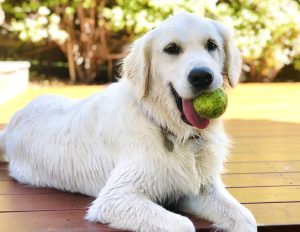
Goldens have a healthy appetite, so much so that they might end up suffering from obesity if their diet isn’t closely monitored.
Your Golden might be used to having food in his bowl throughout the day and also from getting treats from you. Having food available to him throughout the day can cause him to eat from sheer boredom. Speak to your vet about how to feed your Golden so that he stays the muscular, lean dog he was designed to be.
Other than stepping on the scale, you’ll need to consult with your vet if you think your Golden is getting a bit too chubby.
Your vet can recommend the right kind of food for your Golden and the right food portions.
Golden Retrievers can sometimes suffer from hip dysplasia, elbow dysplasia, hypothyroidism, skin conditions, and various eye diseases.
Other dogs can suffer from these ailments too and to avoid disease, it’s important to maintain your dog’s weight and to exercise him.
Goldens are quick growers when they’re young, so you’ll want to take them to the vet frequently to make sure their bones are strong and healthy.
From 3 to 6 months, they have rapid growth which will slow down by the time your puppy reaches 6 months of age.
Because of those potential bone issues, you’ll want to save the heavy-duty play with your pup on grass instead of pavement.
Running on concrete once in a while won’t do your dog any harm but constant running on hard surfaces can be tough on ligaments, joints, and cartilage and cause inflammation and pain.
Some Golden Retriever owners look into the “slow grow” method, although it’s incredibly controversial in some circles.
The whole idea of this slow-grown plan is to ensure a slow rate of growth for puppies between the ages of 0 to 4 months. The slow growth rate allows the healthiest possible development of bones and joints.
You’ll want to bathe your Golden about once a week or so, just to keep that long, silky fur as clean as possible.
As much as you’d like to, avoid bathing your Golden too often as it can dry their skin out. Rather, give the coat a good brush 2 or 3 times a week.
Dogs with folded over ears, like Goldens, are extra susceptible to ear infections.
Make sure to keep an eye out and keep those ears as clean as possible. Floppy-eared dogs like Golden Retrievers and Basset Hounds do tend to have more ear infections than those dogs with upright ears.
They are often water-loving dogs and the moisture trapped in the ears results in the growth of bacteria. This is because, unlike dogs with erect ears, air doesn’t circulate as much with the floppy or folded-down ears.
A Golden Retriever Club of America study showed that 61 percent of Goldens die from some form of cancer, a worrying trend.
Make sure you take your pup to the vet often. It is thought that Goldens have this high probability for cancer as environmental toxins may concentrate on the nails of the dog.
Tests are still undergoing to prove this, but if you suspect your beloved Golden is ill, get him to the vet immediately.
Don’t give your dog chocolate or caffeine. Both will cause serious health issues.
Chocolate certainly is toxic to dogs along with other human foods. Make sure you do research on this. OK, so eating chocolate isn’t fatal, but ingesting it can cause serious illness because of a chemical in it known as theobromine which is similar to caffeine.
Make sure you keep grapes and raisins away from your pup.
Both can cause liver and renal failure. As a health threat to your beautiful pup, their toxicity can cause your puppy to develop acute kidney injury with anuria which is a lack of urine production.
Also, you’ll want to limit the number of onions, garlic, and chives your dog gets to eat.
If they eat too much, they can suffer from anemia. Even onion rings from the takeaway joint are highly toxic for your canine friend. There are a few symptoms to look out for – weakness, decreased appetite, pale gums, vomiting, and elevated heart rate.
Due to how much persin can be found in avocados, you’ll want to avoid letting your dog eat them.
Avos are delicious for us but for your pet, the persin can cause serious health problems and even death. Veterinarians tell us that dogs are particularly resistant to persin than other animals.
While it might be tempting, you’ll want to avoid giving your dog cooked bones of any kind to nibble on.
They tend to shatter and can do some serious internal damage to their guts. Bits of bone can even lodge in the esophagus, and in the gut causing internal bleeding as they pierce the organs.
 More Fun Facts About Golden Retrievers
More Fun Facts About Golden Retrievers
A Golden Retriever can take up to 300-400 breaths per minute, which is pretty standard for larger breeds.
When dogs are overheated or stressed they do breather heavier than normal to cool themselves.
Golden Retrievers are at their most active super early in the morning because of their history of waking up early to hunt.
They’re super active dogs but other possible reasons could be he just wants his human’s attention or he may need to be let out to the toilet.
If you’ve ever wondered why your dog is twitching in their sleep, it’s because they’re dreaming just like humans!
In fact, all dogs dream, causing them to twitch and paddle intermittently.
Golden Retrievers, like most other dog breeds, have a faster heart rate than smaller breeds.
The average is somewhere between 60 to 100 beats per minute. So there is no cause for alarm as a larger dog breed does have this faster heart rate. If there is any cause for concern, get your Golden to the vet.
Your Golden has around 1700 taste buds, way less than the average human with 9000!
Dogs also have taste buds in the back of their throat, so that food that they gulp down they can actually taste!
Goldens usually have around 6-10 puppies at a time, giving you a massive litter of pups!
Some Goldens can even have 12. The Golden’s first litter is usually smaller than later litters.
Your Golden’s sense of smell is up to 100,000 times stronger than yours.
This is because of the many scent receptors they have. For each scent receptor we have, a dog has about 50.
Contrary to popular myths, your Golden can see color!
True, they can’t see the full spectrum of colors that humans can, but they can still see some colors such as blue and yellow.
Goldens don’t just curl up in a ball to be adorable. They do it to keep themselves warm and protect the belly.
They also curl up like that as it’s physically comfortable for them and they feel psychologically safe.
Believe it or not, dogs actually have three separate eyelids.
They have an upper and lower one, along with an extra membrane called the “haw.” While all dogs have this nictitating membrane or haw, there is variance in the coloration in different breeds but they serve a purpose, protecting the eye from injury.
Your Golden’s shoulder blades are not attached to the rest of their skeleton, letting them run at high speeds.
Dog experts say that dogs have floating shoulders giving them speed and agility.
Just like snowflakes, no two dogs have the same two noseprints.
Just like us humans have different fingerprints, dog noses each have their own unique pattern of ridges.
Goldens are a quick, athletic breed that can reach up to 30 mph on average.
It’s why they will suit active outdoor people and they love running at full sprint.
Goldens are the go-to choice for therapy, search and guide dogs all over the world.
Their behavior and endearing characteristics are guaranteed to uplift anyone’s mood.
According to the American Kennel Club, the Golden retriever is the 3rd most popular breed.
Of course, and for good reason, as they are friendly, loving, playful, energetic, and utterly companionable.
Despite being a relatively large breed, Goldens are great dogs for apartments or semi-small living spaces.
While they can live in apartments, you will have to give more attention to their physical and mental needs, taking them out regularly for exercise.
Goldens can be trained to detect epileptic seizures up to a full hour before they actually happen.
It makes them invaluable for people who suffer from them. They’re such sensitive, intelligent dogs and they can be taught to respond to a seizure in someone with epilepsy, often barking when a seizure occurs to get the attention of other people.
They’re great support dogs for kids with disabilities.
Being naturally sensitive, gentle, and attentive, they offer emotional support for anyone with a disability or suffering from depression.
Ancient Egyptians loved their dogs so much that they would shave their eyebrows, smear mud in their hair, and publicly mourn when they died.
Dogs were kept in Ancient Egyptian homes and apart from being terribly sad when their pets died, they would sometimes even mummify their pets and insist on them being buried with their pets.
A Golden Retriever can exhibit something referred to as a “soft mouth,” which lets them be able to hold a ton of stuff in their mouths without breaking it.
So when they carry objects, their soft mouths can carry a variety of things without breaking them, even a raw egg won’t have its shell cracked.
Other dogs can tell their gender, age, health status, and even mood from your Golden’s urine.
That’s because they have these 5 senses which are highly developed and better than humans. By sniffing, they’re able to glean a lot of information about each other in terms of age and health.
Part of the reason your male Golden will raise his leg when doing his business is to make himself look bigger to other dogs while he’s vulnerable.
He also wants to mark his territory and while urinating, in this vulnerable position he wants to send out a warning.
Supposedly, the best dog for attracting a date is the Golden Retriever while the worst is the Pit Bull.
Pit Bulls have unfortunately got themselves a bad name only because of the human owner’s bad treatment of them. Be that as it may, anyone looking for a date stands a better chance with someone who owns a Golden Retriever as they know they won’t leave the date minus an arm or a leg. Anyone though should check out the way a person treats a dog, as they will likely treat their date like that too.
Goldens are a popular choice for movies because of how trainable they are.
Golden Retrievers are like clowns – they love showing off and don’t have a trace of self-consciousness. Add in intelligence and you have the perfect canine film star.
Goldens are a popular pick among celebrities and politicians, including both President Reagan and President Ford.
These people are all achievers in one way or the other, and they appreciate an intelligent dog that adapts well to situations and the people they are with.
Goldens aren’t especially drooly when you compare them to other, bigger dog breeds.
They are people pleasers and will drool over strangers, but their own human family gets the most kisses and loving nudges to show their adoration.
They have a low tendency to snore.
Yes, all dogs snore at some time but some are heavier snorers. The Golden isn’t a heavy snorer. If yours is, rather clear it with the vet as sometimes a health issue could be causing his snoring.
They have a medium tendency to bark, but will often get very excited and bark at their owners to play.
The Golden Retriever certainly isn’t a yapper, and just like his human family, he barks to express himself when he is particularly excited to see his family, he is going to get a treat or he is going for a walk.
They have a low tendency to dig, so you shouldn’t worry too much about your yard.
If he does dig, it could be out of boredom or anxiety, and then there are things you can do. Before you buy a Golden Retriever, understand their need for attention and activity. You can’t just stick him in the backyard and expect him to not show his frustration.
Goldens have been as high as the second most popular dogs on the AKC charts in 1999.
In ’98 and ’99, it was the golden retriever that hit the top of the charts in the popularity stakes and from that time on, the Golden Retriever has been ranked in the top 3 most popular dog breeds.
Studies suggest that Goldens are the sixth least likely breed in terms of aggression.
They’re such fun-loving, easy-going dogs with gentle temperaments and it’s why they’re often therapy dogs. They can be trusted not to bite.
Goldens have webbed toes to help them swim better.
It’s just another of their wonderful qualities. True, their webbed feet aren’t as obvious as those of a duck or goose but if you look, you will see subtle webbing. These are water dogs and this helps them swim better.
Because of their thick coats, Goldens are known to shed a lot.
They shed throughout the year and that is why it is important as an owner of a heavy shedding dog, to ensure you have the proper grooming tools and to brush his shedding coat three times a week to remove loose hair.
Goldens respond best when positive reinforcement is incorporated into training.
Golden Retrievers want to please their human owners and they want to learn. It is why they respond so well to positive reinforcement training techniques. The intelligent Golden Retriever quickly learns that good tasty treats come to them when they please their owners.
Owning your Golden can make you happier and help you live longer
That makes perfect sense, because, in a world of fickle human beings, the constant love and loyalty from a Golden Retriever is like therapy to people who are finding it difficult to trust human beings for true companionship.
Frequently Asked Facts About Golden Retrievers
What are 5 facts about Golden Retrievers?
- They’re sporting, energetic dogs and are going to need plenty of vigorous exercises.
- Their wonderful, gentle, happy-go-lucky natures make them sought-after therapy dogs.
- They’re the most gorgeous puppies that provide you with plenty of laughs and this delightful puppy nature is carried over into adulthood.
- They’re one of the most popular dog breeds in the world and make great family pets.
- They’re ranked as one of the most intelligent dog breeds there are.
What makes Golden Retrievers so special?
Where most dog breeds have one or two exceptional qualities the Golden Retriever has many.
How smart is a Golden Retriever?
The Golden Retriever is ranked smarter than most other dogs and comes in as the 4th most intelligent dog there is, easily managing to learn more than 200 commands.
What do Golden Retrievers like to do?
They’re at their happiest when they’re in the company of their human family, especially when it involves doing fun activities like going on a hike, swimming and playing ball games.
Do Golden Retrievers bite?
Highly unlikely, if ever. If they are feeling sick or feeling threatened they may nip someone. It’s just not in their nature to bite.
What do golden retrievers eat?
When choosing food for your Golden Retriever, it’s important to take into account your dog’s age. It’s why the best dog food manufacturers know how to produce commercially manufactured dog food packed full of nutrients specific to a dog’s unique needs.
Many Golden Retriever owners like to include some homemade treats such as brown rice, chicken, and some vegetables and that’s fine. Avoid most human foods. If in any doubt, speak to your vet.
Why are Goldens so mouthy?
They were bred to retrieve soft birds that their owners had shot. Their soft mouths are able to hold things without the teeth putting any pressure on what it is they have in their mouth.
Conclusion
The Golden Retriever is one of the most loved dogs breeds of all time. To appreciate them as they are, these 101 facts about these Golden Beauties will inspire you to investigate buying a puppy.
Always make sure to choose the most reputable Golden Labrador Retrievers to benefit from all these amazing qualities.
My Golden Retriever Puppies are breeders who are a minefield of information on Golden Retriever puppy facts. Are you in need of a sincere friend today?
There is no doubt that an exquisite, friendly, loving Golden Retriever puppy is going to improve your quality of life.
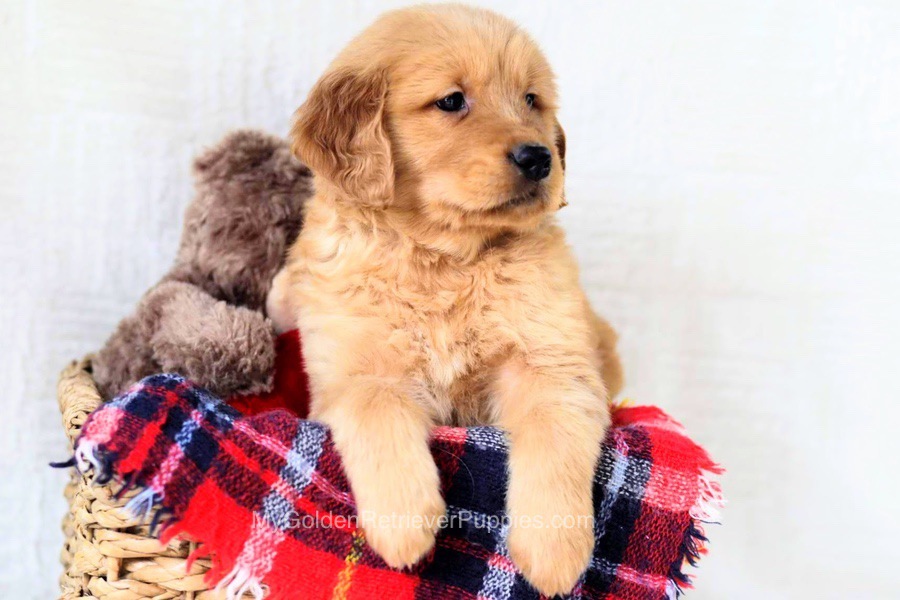
Our website is the best place to find your new golden-haired best friend!
Ready to add a golden retriever to your family?
At MyGoldenRetrieverPuppies, we make it easy for you to find your PERFECT dog.
Come by anytime to see and play with our puppies, meet their parents, visit the farm, and talk to our breeders! We lovingly raise our pups ourselves and go above and beyond to ensure they grow up happy and healthy.
Check out what some of our happy customers have to say (and see real pictures of their golden retrievers) at our testimonial gallery.

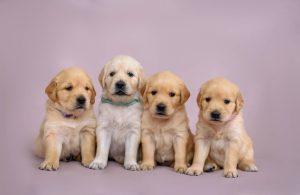
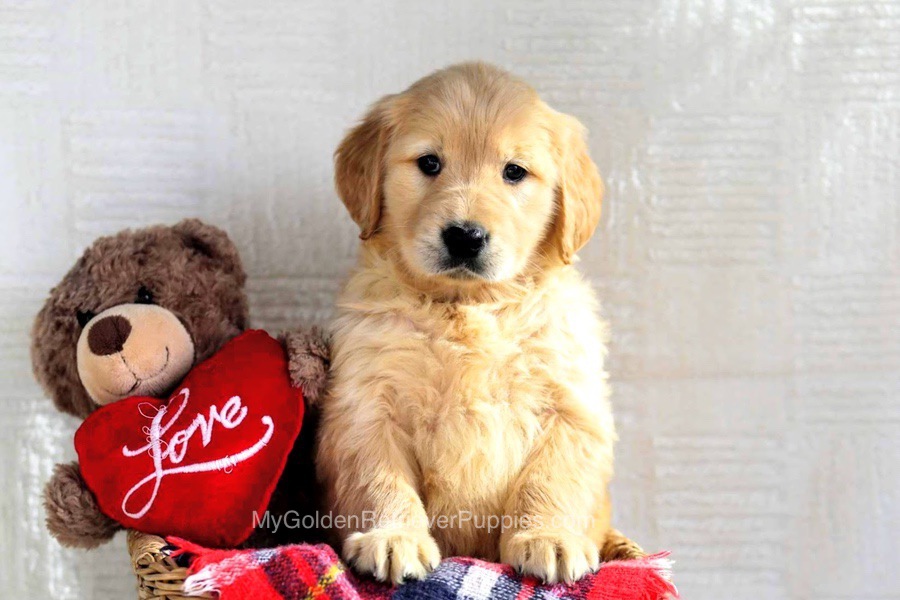 More Fun Facts About Golden Retrievers
More Fun Facts About Golden Retrievers